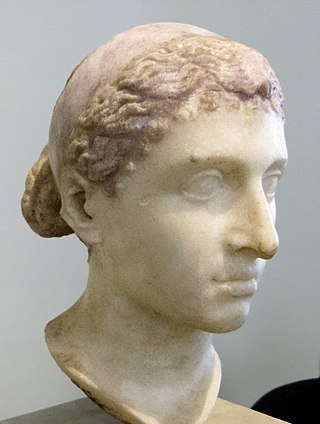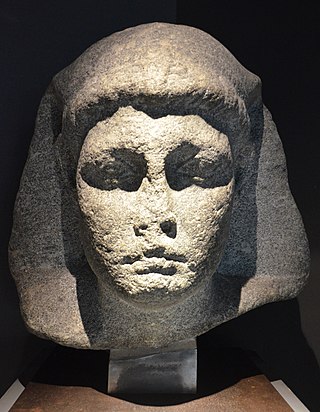Related Research Articles

Alexandria is the second largest city in Egypt, and the largest city on the Mediterranean coast. Founded in c. 331 BC by Alexander the Great, Alexandria grew rapidly and became a major centre of Hellenic civilisation, eventually replacing Memphis, in present-day Greater Cairo, as Egypt's capital. During the Hellenistic period, it was home to the Lighthouse of Alexandria, which ranked among the Seven Wonders of the Ancient World, as well as the storied Library of Alexandria. Today, the library is reincarnated in the disc-shaped, ultramodern Bibliotheca Alexandrina. Its 15th-century seafront Qaitbay Citadel is now a museum. Called the "Bride of the Mediterranean" by locals, Alexandria is a popular tourist destination and an important industrial centre due to its natural gas and oil pipelines from Suez.

The Great Library of Alexandria in Alexandria, Egypt, was one of the largest and most significant libraries of the ancient world. The Library was part of a larger research institution called the Mouseion, which was dedicated to the Muses, the nine goddesses of the arts. The idea of a universal library in Alexandria may have been proposed by Demetrius of Phalerum, an exiled Athenian statesman living in Alexandria, to Ptolemy I Soter, who may have established plans for the Library, but the Library itself was probably not built until the reign of his son Ptolemy II Philadelphus. The Library quickly acquired many papyrus scrolls, owing largely to the Ptolemaic kings' aggressive and well-funded policies for procuring texts. It is unknown precisely how many such scrolls were housed at any given time, but estimates range from 40,000 to 400,000 at its height.

Osiris is the god of fertility, agriculture, the afterlife, the dead, resurrection, life, and vegetation in ancient Egyptian religion. He was classically depicted as a green-skinned deity with a pharaoh's beard, partially mummy-wrapped at the legs, wearing a distinctive atef crown, and holding a symbolic crook and flail. He was one of the first to be associated with the mummy wrap. When his brother Set cut him up into pieces after killing him, Osiris' wife Isis found all the pieces and wrapped his body up, enabling him to return to life. Osiris was widely worshipped until the decline of ancient Egyptian religion during the rise of Christianity in the Roman Empire.

Isis was a major goddess in ancient Egyptian religion whose worship spread throughout the Greco-Roman world. Isis was first mentioned in the Old Kingdom as one of the main characters of the Osiris myth, in which she resurrects her slain brother and husband, the divine king Osiris, and produces and protects his heir, Horus. She was believed to help the dead enter the afterlife as she had helped Osiris, and she was considered the divine mother of the pharaoh, who was likened to Horus. Her maternal aid was invoked in healing spells to benefit ordinary people. Originally, she played a limited role in royal rituals and temple rites, although she was more prominent in funerary practices and magical texts. She was usually portrayed in art as a human woman wearing a throne-like hieroglyph on her head. During the New Kingdom, as she took on traits that originally belonged to Hathor, the preeminent goddess of earlier times, Isis was portrayed wearing Hathor's headdress: a sun disk between the horns of a cow.

Io was, in Greek mythology, one of the mortal lovers of Zeus. An Argive princess, she was an ancestor of many kings and heroes, such as Perseus, Cadmus, Heracles, Minos, Lynceus, Cepheus, and Danaus. The astronomer Simon Marius named a moon of Jupiter after Io in 1614.

The culture of Egypt has thousands of years of recorded history. Ancient Egypt was among the earliest civilizations in the world. For millennia, Egypt developed strikingly unique, complex and stable cultures that influenced other cultures of Europe, Africa and the Middle East.

Cleopatra VII Philopator was Queen of the Ptolemaic Kingdom of Egypt from 51 to 30 BC, and its last active ruler. A member of the Ptolemaic dynasty, she was a descendant of its founder Ptolemy I Soter, a Macedonian Greek general and companion of Alexander the Great. After the death of Cleopatra, Egypt became a province of the Roman Empire, marking the end of the last Hellenistic state in the Mediterranean and of the age that had lasted since the reign of Alexander. Although her first language was Koine Greek, she was the only Ptolemaic ruler to learn and use the Egyptian language.

Ptolemy XV Caesar, nicknamed Caesarion, was the last pharaoh of Ptolemaic Egypt, reigning with his mother Cleopatra from 2 September 44 BC until her death by 12 August 30 BC, then as sole ruler until his death was ordered by Octavian.

The Bibliotheca Alexandrina (BA) is a major library and cultural center on the shore of the Mediterranean Sea in Alexandria, Egypt. It is a commemoration of the Library of Alexandria, once one of the largest libraries worldwide, which was lost in antiquity. The idea of reviving the old library dates back to 1974 when a committee set up by Alexandria University selected a plot of land for its new library. Construction work began in 1995, and after some US$220 millions had been spent, the complex was officially inaugurated on 16 October 2002. In 2009, the library received a donation of 500,000 books from the Bibliothèque nationale de France (BnF). The gift makes the Bibliotheca Alexandrina the sixth-largest Francophone library in the world.

Egypt was a subdivision of the Roman Empire from Rome's invasion of the Ptolemaic Egyptian Kingdom after the battle of Alexandria in 30 BC to its loss by the Byzantine Empire to the Islamic conquests in AD 641. The province encompassed most of modern-day Egypt except for the Sinai, and was bordered by the provinces of Crete and Cyrenaica to the west and Judea, later Arabia Petraea, to the East. Egypt came to serve as a major producer of grain for the empire and had a highly developed urban economy. Aegyptus was by far the wealthiest Eastern Roman province, and by far the wealthiest Roman province outside of Italy. The population of Roman Egypt is unknown, although estimates vary from 4 to 8 million. Alexandria, its capital, was the largest port and second largest city of the Roman Empire.

A serapeum is a temple or other religious institution dedicated to the syncretic Greco-Egyptian deity Serapis, who combined aspects of Osiris and Apis in a humanized form that was accepted by the Ptolemaic Greeks of Alexandria. There were several such religious centers, each of which was a serapeion or, in its Latinized form, a serapeum. An Egyptian name for the temple of Osiris-Apis was Pr-Wsỉr-Ḥp "House of Osiris-Apis".
The Alexandrian school is a collective designation for certain tendencies in literature, philosophy, medicine, and the sciences that developed in the Hellenistic cultural center of Alexandria, Egypt during the Hellenistic and Roman periods.
CDS/ISIS is a software package for generalised Information Storage and Retrieval systems developed, maintained and disseminated by UNESCO. It was first released in 1985 and since then over 20,000 licences have been issued by UNESCO and a worldwide network of distributors. It is particularly suited to bibliographical applications and is used for the catalogues of many small and medium-sized libraries. Versions have been produced in Arabic, Chinese, English, French, German, Portuguese, Russian and Spanish amongst other languages. UNESCO makes the software available free for non-commercial purposes, though distributors are allowed to charge for their expenses.

Serapis or Sarapis is a Graeco-Egyptian deity. The cult of Serapis was promoted during the third century BC on the orders of Greek Pharaoh Ptolemy I Soter of the Ptolemaic Kingdom in Egypt as a means to unify the Greeks and Egyptians in his realm.
The Digital Assets Repository is a system developed at the Bibliotheca Alexandrina (BA) by the International School of Information Science (ISIS) to create and maintain digital library collections and preserve them to future generations.

The Ptolemaic Kingdom was an Ancient Greek state based in Egypt during the Hellenistic Period. It was founded in 305 BC by Ptolemy I Soter, a companion of Alexander the Great, and lasted until the death of Cleopatra VII in 30 BC. Ruling for nearly three centuries, the Ptolemies were the longest and most recent Egyptian dynasty of ancient origin.

Mass media in Egypt are highly influential in Egypt and in the Arab World, attributed to its large audience and its historical TV and film industry supplies to the Arab-speaking world.
The following is a timeline of the history of the city of Alexandria, Egypt.
On Palm Sunday, 9 April 2017, twin suicide bombings took place at St. George's Church in the northern Egyptian city of Tanta on the Nile delta, and Saint Mark's Coptic Orthodox Cathedral, the principal church in Alexandria, seat of the Coptic papacy. At least 45 people were reported killed and 126 injured. Amaq News Agency said the attacks were carried out by a security detachment of ISIS.
Kathleen Teresa Martínez Berry is a Dominican lawyer, archaeologist, and diplomat, best known for her work since 2005 in the search for the tomb of Cleopatra in the Taposiris Magna temple in Egypt. She heads the Egyptian-Dominican mission in Alexandria, and is currently minister counselor in charge of cultural affairs at the Dominican embassy in Egypt.
References
- Arseneault, Michel. "Alexandria, from papyrus to the Internet." The UNESCO Courier 52, no. 4 (April 1999): 40–42.
- Bilboul, Roger. "The Library of Alexandria Reopens." Information Today 19, no. 11 (December 2002): 26.
- Watson, Bruce. "Rising Sun." Smithsonian, April 2002.